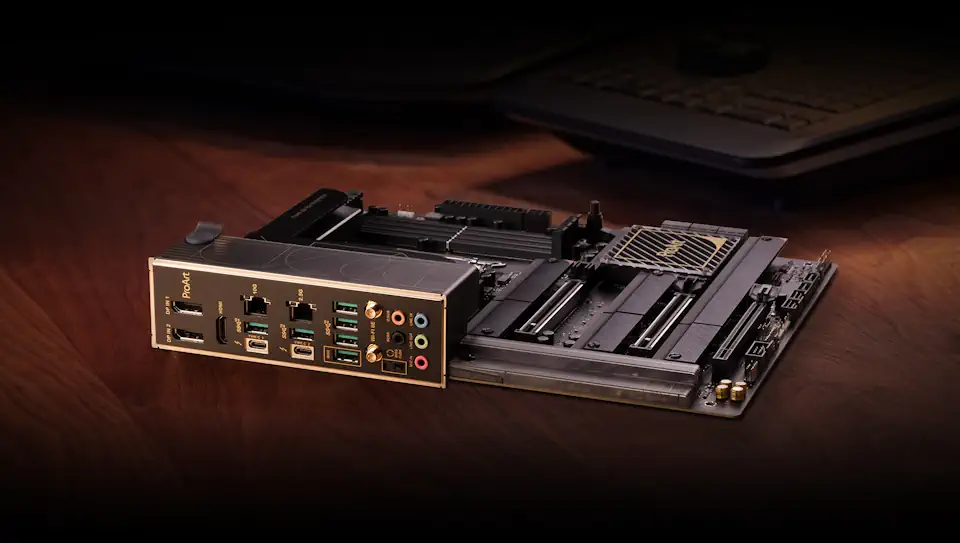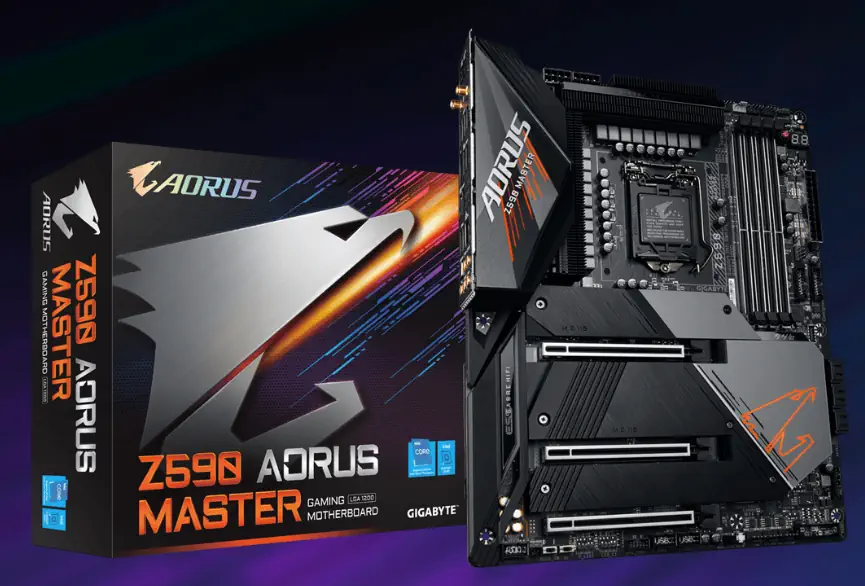
Motherboards for music production. Are you new to music production or a seasoned pro seeking a seamless studio session?
Picture your workstation running without delays so you can concentrate on being creative.
The motherboard, often overlooked, is the heartbeat of any music production PC setup.
The computer allows you to add more sound cards, RAM, and storage devices, keeping your music production computer up-to-date and robust.
Continue reading as I explore the top motherboards designed for music production.
“Please note that this article contains affiliate links, meaning I may earn a commission from purchases. Read my full disclosure.” “As an Amazon Associate, I earn from qualifying purchases. “
What are the best motherboards for music production?
1. Asus – ProArt Z890-CREATOR WIFI

Overview
The Asus—ProArt Z890-CREATOR WIFI is a top pick for producers in 2023. It boasts excellent audio quality and robust features for music production.
The ASUS motherboard is compatible with Intel Core processors and supports fast RAM, making it ideal for music production.
Features and Benefits
- Intel LGA 1700 Socket: This platform uses the newest Intel Core processors, DDR5 RAM, and Windows 11.
- It enhances computer speed performance and gives users a competitive advantage.
- Robust Performance: This system has 16+1 power stages, a ProCool II power connector, and high-quality components.
- It provides reliable and steady power. This provides a stable operating environment, ensuring optimal performance under various loads.
- Comprehensive Thermal Design: The cooling system maintains optimal temperatures with a large VRM heatsink and M.2 aluminum heatsinks. The heat dissipates.
- The system stays at the right temperature, so it works well and lasts longer.
- Extensive Connectivity: For fast data transfer, you can connect using Dual Thunderbolt 4 Type-C ports, Ethernet, WiFi 6E, and USB 3.2 ports.
- This flexibility allows for easy interfacing with various devices, enhancing productivity.
- Advanced Security: The in-built security suite provides robust safeguards for system protection.
- You can manage USB ports and stop specific software to stay safe from security threats. Use ASUS Prime Control Center Express for added peace of mind.
- These options give you comprehensive control over system access.
- ProArt Features: The ProArt series has unique features. You get AI Noise Cancelation and ProArt Creator Hub.
- These features clear online communication and help creative professionals do their best work.
- Trusted Stability: This system is reliable because it undergoes rigorous testing for 24/7 operation.
- It also goes through extensive compatibility validations and uses SafeSlot technology.
- These aspects contribute to enhanced system durability, ensuring long-term dependable performance.
- PC DIY-Friendly Features: The system is designed for PC DIY enthusiasts. It has features like SafeDIMM, Q-LED, M.2 Q-Latch, BIOS FlashBack, and FlexKey.
- These features help you when you do it yourself. They allow you to put things together, fix problems, and control things how you want.
Conclusion
The new computer system has advanced features like the Intel LGA 1700 Socket.
The computer also performs well and stays cool, making it suitable for demanding tasks.
This works with the newest Intel Core processors and DDR5 RAM and supports Windows 11.
The system guarantees a stable power supply and controls heat for heavy work.
The ProArt series is designed for creative professionals. It includes AI Noise Cancellation and the ProArt Creator Hub.
You will have an amazing computer for music production with this motherboard.
2. GIGABYTE Z590 AORUS

Overview
Another excellent option is the Gigabyte Z590 Aorus. This motherboard has superb sound quality and many slots for adding sound cards and peripherals.
Features and Benefits
- 10th and 11th Generation Intel® Core™ Series Processor Compatibility: Enabling high performance and multitasking makes your device run smoother and faster.
- Four DIMMs for Dual Channel Non-ECC Unbuffered DDR4 Memory: This configuration allows for greater memory capacity and faster data transfer, enhancing system performance.
- Intel® Optane™ Memory Integration Ready: This makes the system faster and reduces loading times for common apps, giving users a better experience.
- Digital VRM Solution: This helps the system stay stable and last longer when handling heavy work.
- Shielded Memory Routing: This feature prevents electromagnetic interference, ensuring the stability and integrity of data transmission.
- Advanced Thermal Management System: This system dissipates heat, prevents overheating, and maintains optimal performance during heavy processing tasks.
- Inbuilt Intel® WiFi 6E 802.11ax 2T2R & BT 5 Connectivity: Offers fast and stable wireless connections, improving online gaming, streaming, and web browsing.
- High-Grade 125dB SNR AMP-UP Audio: Get the best sound for music and videos with high-quality audio.
- AQUANTIA® 10GbE BASE-T LAN with cFosSpeed: The internet connection is fast and reliable, with no delays. It’s great for streaming videos.
- Triple Ultra-Fast NVMe PCIe 4.0/3.0 x4 M.2 Support: This facilitates quick data transfer and boot times, improving system efficiency and performance.
- RGB FUSION 2.0 Feature: You can customize your system’s lighting to make it look and feel unique.
- Smart Fan 6 with Several Temperature Sensors: The fan speeds adjust based on temperature to keep the system cool and last longer.
- Q-Flash Plus for BIOS Updates: You can update the BIOS without installing a CPU, memory, or graphics card, making it simple to keep your system up to date.
Conclusion
Combining these advanced features ushers in a new performance and user experience era.
The system is compatible with Intel CPUs of the 10th and 11th Generation. It supports Non-ECC Unbuffered DDR4 Memory, which makes it fast and responsive.
Intel® Optane™ Memory improves system performance by making it faster and more reliable. It includes a high-grade Digital VRM Solution and shielded memory routing.
The Advanced Thermal Management System and Smart Fan 6 features to manage heat. They ensure stability, even during heavy processing tasks.
This allows your PC for music production to run long and hard.
What is the importance of choosing the correct motherboard for music production?
1. Compatibility with music production software
Pick a motherboard for music production that works with your software.
Each sound production software has different hardware requirements. Choose a compatible motherboard to ensure smooth operation and optimal performance.
2. Sound quality and audio processing capabilities
Quality of sound is a critical aspect of music production.
A good motherboard should have great audio processing abilities. It should produce high-quality sound and have low delay.
This ensures your music sounds crisp and detailed without audio distortion or delays.
3. Expansion options for future upgrades
If you want to keep up with technology and production, pick a motherboard that can be upgraded in the future.
A motherboard with many slots lets you add RAM, sound cards, and hard drives. You can customize your setup to fit your needs.
How does the choice of processor affect music production?
1. Importance of a powerful CPU for handling multiple tracks and effects
Music production involves working with various tracks, products, and plugins. A powerful CPU is crucial for addressing the computational demands of these tasks.
Your CPU is like a conductor. It keeps the rhythm and harmonizes tracks and effects in your audio workstation. It gives you the power to create magic.
A powerful CPU ensures your recordings are smooth and your ideas don’t freeze.
So, invest in a robust CPU if you want to keep your creativity flowing and your tracks crisp.
2. CPU compatibility with different motherboards
Make sure the processor you choose for your PC works with your motherboard.
Other motherboards, such as Intel LGA, AMD AM4, or AMD Ryzen, support specific CPU sockets. To improve performance and stability, ensure the CPU and motherboard are compatible.
What are the crucial features to consider in a motherboard for music production?
1. Enough RAM slots and maximum supported memory
To make music, you usually need a lot of RAM. RAM helps with samples and plugins.
You can do many tasks if your computer can hold big memory modules and play audio.
2. USB, Thunderbolt, and audio ports for connecting external devices
MIDI controllers, audio interfaces, and external hard drives are crucial for production.
If the motherboard has enough USB ports and audio jacks, it’s easy to connect external devices.
Thunderbolt connectivity provides super speedy connections and can handle several devices at once. It’s like having a highway with no speed limit for your data!
3. Expansion slots for sound cards and other peripherals
Enhance your production setup using sound cards and audio devices. With these, you’ll improve performance and add new features.
The motherboard needs slots for extra cards and peripherals, like PCI or PCIe.
Why is it essential to have a reliable audio interface with your motherboard?
1. High-quality analog-to-digital and digital-to-analog conversion
An interface serves as the bridge between your motherboard and professional audio equipment.
It ensures high-quality analog-to-digital and digital-to-analog conversion, preserving the audio signal’s integrity throughout the recording and playback process.
A reliable interface improves the clarity and accuracy of your digital audio production.
2. Low latency performance for real-time monitoring
Real-time monitoring is crucial in music production, allowing you to hear the playback instantly without any noticeable delay.
A reliable interface and a low-latency driver ensure minimal audio latency, providing a seamless monitoring experience while recording or mixing tracks.
3. Compatibility with professional audio production software
Professional audio production software often requires specific audio interfaces for optimal performance.
Ensuring compatibility between your audio interface and your software is essential to avoid compatibility issues and ensure the smooth operation of advanced features, such as low-latency recording and high-resolution audio playback.
DDr4 vs. DDr5 Music Production RAM
In music production, you need fast and reliable RAM. It helps with big files and complex software.
DDR4 has been the standard and is great for making music. Yet, the introduction of DDR5 brings some promising improvements.
DDR5 provides faster data transfer rates. It improves performance with higher bandwidth and memory frequency.
DDR5 can be helpful to projects with many tracks, plugins, and virtual instruments.
DDR5’s larger memory capacity allows you to store more samples and audio files without streaming.
DDR4 is enough for music production. However, DDR5 may bring smoother workflow and improved productivity.
DDR5 is becoming more common and cheaper. It is becoming the choice for music producers who want better system performance.
FAQ: Motherboards for Music Production
1: What are the key factors when choosing a motherboard?
A: When choosing motherboards for music production, consider the processor it works with and the number of RAM slots. Also, think about the expansion slots for sound cards or extras. And the connections available.
2: Is it necessary to have a specific type of motherboard?
A: Having a production-designed motherboard is optional. But it can improve audio, data transfer, and performance.
3: Can I use a gaming motherboard?
A: Yes, you can use a gaming motherboard. Gaming motherboards are for gaming and have better port options than music motherboards.
4: How much RAM do I need?
A: The amount of RAM you need for production depends on the complexity and size of your projects.
Having at least 16GB of RAM is ideal, but 32GB or even 64GB may be necessary for more demanding tasks.
5: What operating system is best?
A: The choice of operating system depends on personal preference and the software you plan to use.
Windows and macOS both have options for making music. Two popular choices are Windows 10 and MacOS Ventura.
